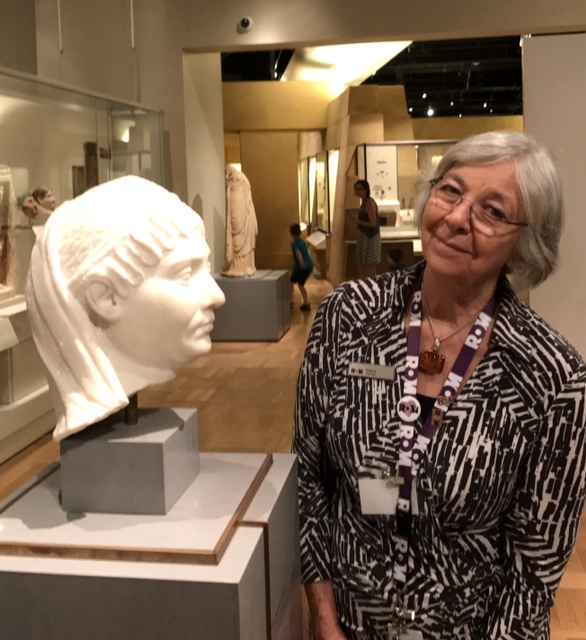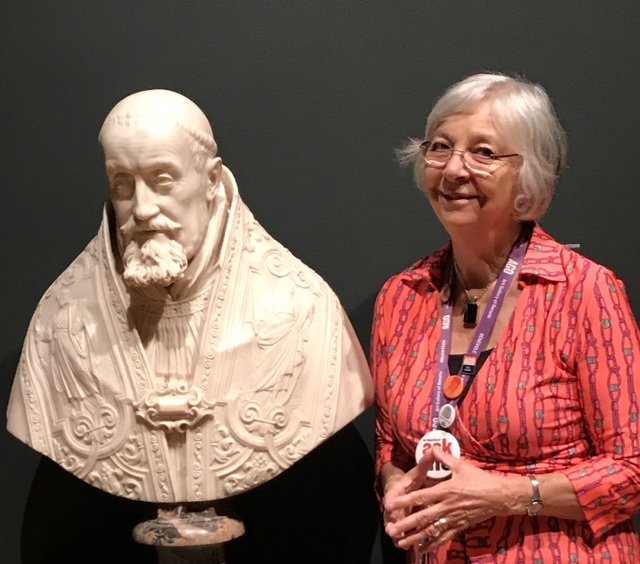Many of our AGO volunteers also offer their time and expertise elsewhere. We will be highlighting a few of them over the next few weeks. This week: Valerie Fairclough “double dips” at the ROM.
How did you get involved at the ROM?
For me, it happened by accident. I had long waited for the opportunity to volunteer at AGO and finally, 8 years ago, turned in desperation to the ROM. I needed to be somewhere other than at home in (too early!) retirement, and preferably somewhere where I could share my passion for History and the Arts. As serendipity would have it, no sooner had I committed to the ROM, I received an email from our beloved Holly, who had discussed my application with my friend, Gallery Guide Adrienne Pollak. Long story short, I was soon happily volunteering at both. Rather than “double duty” it felt like “double dipping”! At the ROM I have worked as a Visitor Guide, ROM Walker, Gallery Interpreter (all concurrently!) and Docent. I have now narrowed it down to mostly Docent and periodically helping with training of G.I.s.
How is the ROM volunteer program organized compared to the AGO’s?
ROM volunteers do not enjoy an amazing Melissa taking care of them, and instead are recruited, trained, organized and monitored by the Department of Museum Volunteers. This is a self-governing and independent body that has liaison with ROM visitor department staff and curators. Within the DMV there are several separate volunteer committees apart from the docents, all holding meetings once a month, and all incorporating an educational component. Learning is ongoing, just as it is at AGO. As well as fulfilling traditional volunteer duties in interfacing with the public and giving free tours, the Docent Committee raises significant revenue by giving a great many paid private group tours, which are actually marketed by ROM staff but filled by the volunteers. The money raised and donated is designated for ROM Research only, not the everyday running of the plant.
What is touring like at the ROM?
I soon discovered that the approach to Interpretation at each museum is very different. ROM volunteers who interact interpretively with the public, including Docents who give tours, may only give information from approved sources, such as the ROM curators, the Smithsonian or the British Museum and may offer no personal opinions or judgements! Personal research from other sources is not welcomed. This is because we represent the museum and the museum must always give accurate information about the objects on display. The information for volunteers is largely provided by volunteer Section Leaders in curator approved packages, and the volunteer puts together their own visitor experiences and tours from these. Tours must be “vetted” (horrid term!) for accuracy and presentation by a peer evaluator and are strictly timed, with an expectation of 45 minutes, and no more than 50 minutes. This applies to both gallery and exhibition tours. All Museum Highlights tours were vetted annually until very recently when it was changed to once every two years. Everyone is evaluated, no matter how long they have been touring. It keeps us on our toes, fresh and updated, as we have to add something new for every vetting! (I know – who would keep giving the same old tour!)
What is your relationship to the other volunteers?
My entire life background has been in Studio Art, Art History, and Teaching, so the AGO is my oasis, where I can indulge myself in sharing my passion for art with our visitors, with super knowledgeable fellow Gallery Guides and with dedicated Information Guides. Opinions are welcomed, discussion and speculation encouraged, ideas shared!! Art is open to interpretation after all, and our role is to help visitors engage with what they’re seeing and enhance their gallery experience. And of course we also have our familiar day teams of Gallery Guides and Information Guides that become so close and supportive of each other and even socialize together. That does not happen at ROM, as our tours are booked 2 months in advance and can be on different days of the week, at different times, as we choose. Friendships are established, nevertheless, and there are organized social gatherings. Special Exhibition teams train together and become closer. There are wonderful people volunteering at ROM as well as at AGO.
What do you like about each institution? What do you find challenging?
I do enjoy sharing the ROM’s amazing collection with visitors from all over the world and all walks of life, just as we do at AGO. Above all, I value the diverse personal learning that I pursue at ROM. We can choose our Special Exhibitions, and they are not obligatory. The current Spiders exhibition has been a challenge for me, as science is not my area of expertise, but it has aroused an excited interest that I share with my family and others. We study the critters and their creations in the house and garden and marvel at the characteristics that have allowed them to survive for 300 million years! Our species should be so lucky! What can we learn from them?
Is there much cross-over between the AGO and the ROM?
I am finding more and more connections between my two roles. The new ROM Director, Josh Basseges, recently changed the mandate of ROM from “Natural Science and Culture” to “Art, Science and Culture”. That removes any guilt I have felt in the past for including several works of Fine Art in my Highlights tours! The Iris Van Herpen/ Philip Beesley show had strong links to conceptual art – one Van Herpen dress was inspired David Altmejd’s “Index”! The recent “Anishinaabe Art and Power” exhibition tied in with the mandate of the AGO Indigenous Art collection, and we trained and partnered with Indigenous docents for these tours. The recent Chihuly show was a wonderful combination of art and science and a great opportunity to share my art perspective with the visitors.
Would you recommend taking on other volunteer roles?
I am very (actually TOO!) busy, as I also have a family here in Toronto and have other interests that I pursue, but to choose between them would be agony! For that reason, I carry on regardless, sometimes whining a little, and would recommend it only to the foolhardy and other “gluttons for punishment” like myself. To the veterans who have been doing this double duty much longer than I have, I would like to say, well done! You have my greatest respect and admiration! To the AGO Gallery and Information Guides I would like to say, you are in a good place. No need to go anywhere else!
Thanks Valerie!
Do you have a story to tell about volunteering elsewhere? Let us know and we may feature you too!

